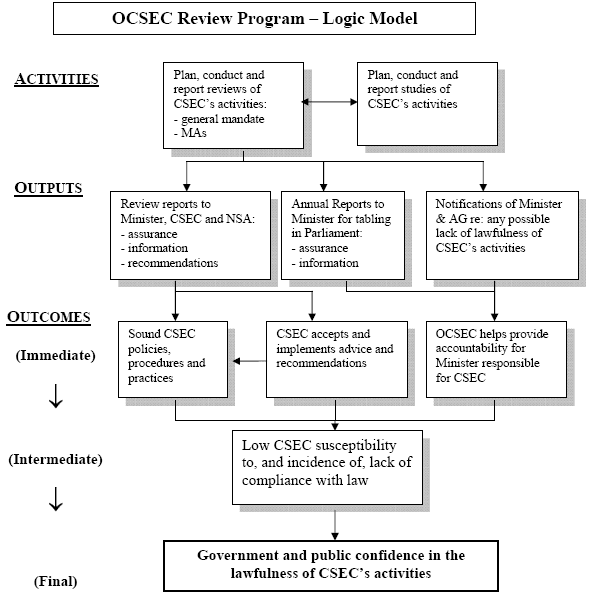Common menu bar links
Breadcrumb Trail
ARCHIVED - Office of the Communications Security Establishment Commissioner
 This page has been archived.
This page has been archived.
Archived Content
Information identified as archived on the Web is for reference, research or recordkeeping purposes. It has not been altered or updated after the date of archiving. Web pages that are archived on the Web are not subject to the Government of Canada Web Standards. As per the Communications Policy of the Government of Canada, you can request alternate formats on the "Contact Us" page.
Section II – Analysis of Program Activity by Strategic Outcome
2.1 Strategic Outcome
The Communications Security Establishment Canada performs its duties and functions in accordance with the laws of Canada and with due regard for the privacy of Canadians.
The following section describes OCSEC program activity and the expected result of this activity. This section also explains how OCSEC plans on meeting the expected results and presents the financial and non-financial resources that will be dedicated to the program activity.
This section will contain information on OCSEC's program activity as well as the internal services activity.
2.1.1 Program Activity – Review Program
| Program Activity Expected Results | Performance Indicators | Targets |
|---|---|---|
| CSEC's activities and operations are conducted in accordance with the law while respecting the privacy of Canadians. |
Level of compliance % of recommendations implemented |
Increase level of compliance Increase the % of recommendations implemented (more precise targets will be developed over the planning period) |
| Privacy of Canadians is protected | OCSEC will be working with Treasury Board officials to develop and implement a comprehensive Management, Resources, and Results Structure including a fully functioning performance measurement framework in 2009-10. |
Financial Resources ($ millions)
| 2009-10 | 2010-11 | 2011-12 |
|---|---|---|
| 1.3 | 1.3 | 1.3 |
Human Resources
| 2009-10 | 2010-11 | 2011-12 |
|---|---|---|
| 6 | 6 | 6 |
The review program includes research, monitoring, planning, the conduct of reviews and the reporting of results. In addition, it also includes consultations and communications, including outreach, with stakeholders and the public.
The following logic model provides a graphic description of how the review program functions.
OCSEC Review Program – Logic Model

Planning Highlights
In order to achieve the intended results, OCSEC plans to undertake the following:
- Plan, conduct and report the results of reviews – OCSEC will continue to complete its reviews in accordance with its approved three year plan. The planning process is a risk based approach developed in collaboration with the CSEC and based in part on a review of key documentation as well as emerging issues. The three year plan is a living document that is revised (and updated as required) every 6 months.
- Operate effectively – OCSEC intends to develop targets for the performance of its reviews to ensure that they are on-time and on-budget. Setting targets is difficult because each review differs from the other. However, it is critical to incorporate precise review planning into the budgetary process.
- Operate efficiently – OCSEC will continue to look at the review process to identify opportunities to be more efficient. Increased training and the use of better review tools will be supported in order to increase efficiency.
- Collaboration – In May 2005, an OCSEC-led initiative was the creation of the Review Agencies Forum (RAF). RAF meets twice each year to discuss matters of common interest to its members. In addition to OCSEC, the current members of RAF are:
- The Security Intelligence Review Committee (SIRC)
- The Inspector General of CSIS
- The RCMP Public Complaints Commission
- The Office of the Privacy Commissioner
OCSEC will continue to work with the security and intelligence community, both domestically and internationally. These collaborations (meetings, associations, conferences, etc.) allow information and experience to be shared, differing methodologies to be studied and best practices to be adopted.
2.1.2 Program Activity – Internal Services
Financial Resources ($ millions)
| 2009-10 | 2010-11 | 2011-12 |
|---|---|---|
| .2 | .2 | .2 |
Human Resources (FTEs)
| 2009-10 | 2010-11 | 2011-12 |
|---|---|---|
| 3 | 3 | 3 |
In order to fully support the review program, OCSEC plans to undertake the following:
- Achieve administrative independence during 2009-10 – since its inception in 1996 until April 2008, OCSEC was funded by the Department of National Defence and received administrative support from the Privy Council Office. Administrative independence will require OCSEC to comply with the legislative reporting requirements of the central agencies. OCSEC needs to resource (staff or contract) and provide the full range of administrative services, including finance, human resources, administration, informatics, information management, and security. The OCSEC operational policy manual will continue to be updated as internal services are moved away from the PCO and are established and operated within OCSEC.
- Establish a Management Accountability Framework – Once resources are in place and the systems are operational, OCSEC will establish a management accountability framework to ensure that internal services are conducted in a timely and cost effective manner.
- Conduct operational and management reviews – Internal operational and management reviews are conducted on a cyclical basis; these will be continued over the planning period.
- Acquire additional secure office space – Of immediate concern is the acquisition of additional secure office space to accommodate the additional resources necessary to achieve administrative independence.
Benefits for Canadians
OCSEC's activities support the Commissioner's assurance to the Minister, Parliament and to all Canadians that the activities undertaken by CSEC are in compliance with the law and that the privacy of Canadians has been safeguarded.
